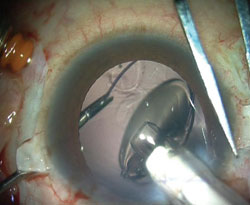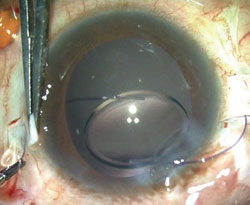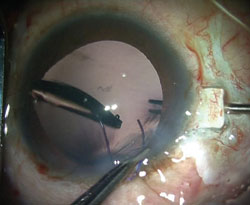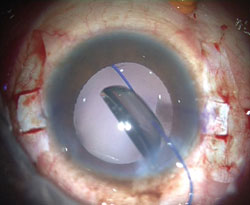Glued IOL procedure evolves with use of handshake technique
Another change to the technique is the use of foldable IOLs that can be inserted through small self-sealing incisions.
 Amar Agarwal |
We first proposed the glued IOL as a technique for posterior chamber IOL fixation in eyes with absent or insufficient capsular support in 2007. Since then, many cases have been done with this technique, with the longest follow-up being more than 3 years. The technique has also evolved, and its application has been extended to many different scenarios and as part of combined surgeries.
The basic technique, as we first performed it, consisted of creating two 2.5 mm × 3 mm lamellar scleral flaps exactly 180° apart. Sclerotomies were made 1 mm to 1.5 mm from the limbus under these flaps. A 23-gauge vitrector introduced through this sclerotomy or an anterior vitrector introduced through a corneal paracentesis was used to perform a thorough anterior vitrectomy. A corneoscleral section large enough to introduce the IOL was created, and the leading haptic of the IOL was introduced through the section. The leading haptic of the IOL followed by the trailing haptic were then consecutively exteriorized through these sclerotomies using 23-gauge MicroSurgical Technology (MST) forceps. The haptics were then fixed transsclerally into scleral pockets created at the edge of the flap with a 26-gauge needle. The scleral flaps were then stuck down using fibrin glue. Throughout the entire procedure, either a 23-gauge infusion cannula, which is easy to use for anterior segment surgeons as well, or an anterior chamber maintainer was used to keep the globe well formed.
Advantages of foldable glued IOL
The glued IOL technique has evolved over time, with one of the greatest changes being the use of foldable IOLs for performing this surgery. This makes it possible to perform the entire procedure through small self-sealing incisions. This has the intraoperative advantage of having a well-formed globe throughout all the steps of surgery. It eliminates iris prolapse during IOL insertion and wound suturing and significantly decreases time of surgery because there is no need to suture the corneoscleral section. The risk of having an expulsive hemorrhage is also reduced. This foldable glued IOL has postoperative advantages of doing away with complications associated with larger wounds, such as postoperative wound leak and shallow anterior chamber, as well as decreases the astigmatism associated with a large wound.
Foldable glued IOL technique
Any three-piece foldable IOL can be used for this technique. All the steps remain the same as in the original procedure except the technique of IOL insertion into the anterior chamber. Once the infusion cannula/anterior chamber maintainer has been fixed and the flaps and sclerotomies are made, a 2.8-mm keratome is used to make a corneal incision. This may be enlarged slightly to allow easy insertion. A side port may also be made to allow the surgeon easier maneuverability, and it can be used as a future access point, if required. The three-piece foldable IOL is loaded into the injector, and the injector tip is introduced into the anterior chamber. At the same time, 23-gauge MST forceps are introduced through the sclerotomy under the scleral flap. It is preferable to have a pushing-type injector, although a screwing-type injector may also be used with the assistant gently screwing it as the surgeon holds the injector with one hand and the forceps with the other hand. It is also advisable to have the injector tip within the mouth of the incision and not use wound-assisted injection of the IOL, which can lead to a sudden, uncontrolled entry of the IOL into the eye and a consequent IOL drop.
 Figure 1. Leading haptic of the foldable IOL is grasped at its tip by the 23-gauge MST forceps introduced through the sclerotomy. |
 Figure 2. The leading haptic is exteriorized through the sclerotomy. Images: Agarwal A |
 Figure 3. First haptic is held by an assistant while the surgeon flexes the second haptic into the anterior chamber in the jaws of the forceps introduced through the second sclerotomy. |
 Figure 4. Both haptics are externalized and are then tucked into scleral tunnels made at the edge of the scleral flaps. |
 Figure 5. Another case showing the leading haptic lying free within the vitreous cavity. |
 Figure 6. The handshake technique is used to bimanually transfer the haptic between the two hands until it is caught at the tip and then externalized. |
As the IOL is being injected into the anterior chamber, the tip of the haptic is caught with the forceps and exteriorized while injection is gently continued (Figures 1 and 2). The injector is then slowly withdrawn so that the second haptic is left trailing outside the wound. The first haptic is then held by an assistant while the surgeon flexes the second haptic into the anterior chamber in the jaws of the forceps introduced through the second sclerotomy (Figure 3). This haptic is also thus externalized out (Figure 4). A bent 26-gauge needle is used to create a tunnel in the direction of the exteriorized haptics at the edge of the scleral flap. Vitrectomy is used to clear up the scleral bed in case any vitreous has prolapsed out. Both haptics are then tucked intrasclerally. Centration of the IOL is checked, and if it is not well-centered, the degree of tuck of the individual haptics is adjusted until the lens becomes well-centered. The scleral bed is then dried, and fibrin glue is applied. The scleral flaps are glued down. Fibrin glue is then used to seal the main port and the side port by applying over the incisions. The conjunctiva is also closed with fibrin glue.
Handshake technique
The exteriorization of the haptics is a key step in the glued IOL technique. Because the surgeon is maneuvering with both hands simultaneously, with one hand injecting the IOL while the other grasps and exteriorizes the haptics, he or she needs to be familiar with the handshake technique as a means of transferring the haptic from one hand to the other. If one of the haptics is not caught or if it gets released accidentally after grasping it, the situation can be easily resolved using this technique (Figure 5). It utilizes two MST forceps, one of which holds one haptic. Depending on ease of access, the other MST forceps are introduced through the opposite sclerotomy or through the side port. The first hand then transfers the haptic into the second MST forceps such that the first hand now becomes free (Figure 6). It is essential to hold the haptic at its tip before exteriorizing it so that it does not snag on the sclerotomy while being brought out. For this reason, this handshake transfer of the haptic between the two MST forceps is continued until the tip of the haptic is caught by the forceps on the side to which the haptic is to be exteriorized. This technique thus allows easy intraocular maneuvering of the entire haptic or IOL within a closed globe system.

- Amar Agarwal, MS, FRCS, FRCOphth, is director of Dr. Agarwal’s Eye Hospital and Eye Research Centre. Prof. Agarwal is the author of several books published by SLACK Incorporated, publisher of Ocular Surgery News, including Phaco Nightmares: Conquering Cataract Catastrophes, Bimanual Phaco: Mastering the Phakonit/MICS Technique, Dry Eye: A Practical Guide to Ocular Surface Disorders and Stem Cell Surgery and Presbyopia: A Surgical Textbook. He can be reached at 19 Cathedral Road, Chennai 600 086, India; fax: 91-44-28115871; e-mail: dragarwal@vsnl.com; website: www.dragarwal.com.
- Disclosures: Drs. Jacob, Kumar and Agarwal have no direct financial interest in the products discussed in this article, nor are they paid consultants for any companies mentioned.
